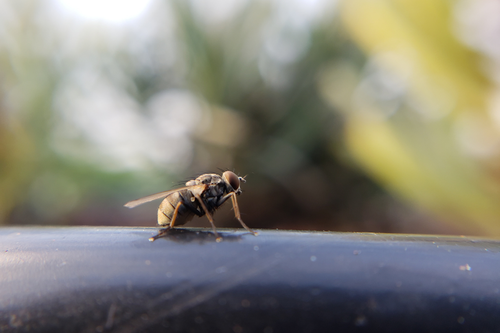
To reach their next meal, tiny killer flies (Coenosia attenuata) sometimes dive bomb their prey and when they do, they reach accelerations that surpass those of diving falcons. In research led by scientists from the University of Minnesota, University of Cambridge and University of Lincoln, the team found that killer flies can reach accelerations of more than three times what would be provided by gravity alone.
“The killer fly does not seem to account for the help gravity provides when attacking from above,” said study author Paloma Gonzalez-Bellido, an associate professor at the U of M’s College of Biological Sciences. “Instead, we found that the killer fly is beating its wings incredibly fast to conduct a powerful, downward aerial strike. Even if it misses, the gravity-assisted strike still brings it closer to its target and may even slow the prey down.”
To get their results, the researchers built a transparent ‘flight arena’ and flew a dummy prey target through it. Killer flies were filmed with high-speed video cameras as they attacked the target. Researchers then reconstructed the entire attack sequence from the slow motion data into a 3D model.

The study, published in the Journal of the Royal Society Interface, found that the killer flies:
- can accelerate up to 36 m/s2 or 3.6 times the acceleration due to gravity (falcons, the fastest birds to hunt in the air, reach accelerations of 6.8 m/s2 after folding in their wings and letting gravity help them dive);
- reached much higher accelerations during their flight when taking off from the ceiling of the arena; and
- beat their wings at a similar rate wherever they launched from, indicating their flight speed is determined by a combination of wing power and gravity.
“When killer flies took off from the floor or walls of the arena, they moved at the time when they could take the shortest path to the target. But they couldn’t manage that when they took off from the ceiling because the high acceleration caused by gravity changed the expected flight path,” said study author Sergio Rossoni, a Ph.D. student at the University of Cambridge.
What makes the killer fly dive unusual is that most insects that hunt in the air usually attack their prey upwards because it is easier to pick out prey against a less cluttered visual field. Since killer flies are tiny and have the fastest known visual responses in the animal kingdom, their high sensitivity to motion and maneuverability may compensate for the challenges involved with a downward strike.
“What this research also shows is that there are different strategies to use when flying,” said study co-author Gregory Sutton, a research fellow at the University of Lincoln. “When you are incredibly small like the killer fly, power is important: the added friction of air doesn’t get in your way and you are able to accelerate at incredible speeds when gravity doesn’t have the biggest control on you.”
This research may have implications for the further development and design of small machines, such as drones to monitor the atmosphere. Funding for the research was provided by the Air Force Office of Scientific Research, the Biotechnology and Biological Sciences Research Council, and the Royal Society.
- Categories:
- Science and Technology
- Science





